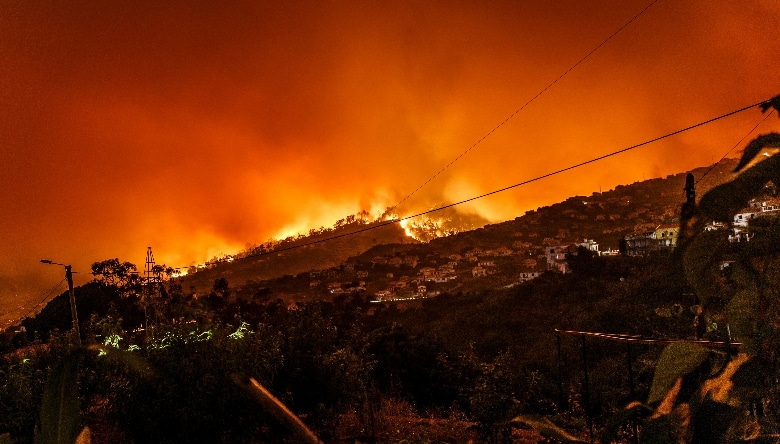Europe witnessed a year of contrasting weather events in 2023, with heatwaves and wildfires alongside flooding and drought, according to the European State of the Climate 2023 report, released jointly by the UN’s weather agency, the World Meteorological Organization (WMO), and the EU’s Copernicus Climate Change Service.
Europe is currently the fastest-warming continent, with its temperatures rising at twice the global average rate. In 2023, the changing climate broke several records, including the largest wildfire on the continent and the highest number of days with ‘extreme heat stress’.
The report showcases that the only certainty in 2023 was that the frequency and severity of extreme events are increasing. Storms, floods, and wildfires combined caused the deaths of more than 150 people in 2023 according to preliminary estimates.
Celeste Saulo, WMO Secretary-General , said it underlined a “need to leverage science to provide solutions for the good of society”.
Disparities across Europe
It was an extremely wet year, with 7% more precipitation than average over the continent. Flooding affected around 1.6 million people, with widespread floods in Italy, Greece, Slovenia, Norway and Sweden. Some areas of Greece had the equivalent of a year’s worth of rainfall in one day.
In May, European river basins including the Loire, Danube, and Rhine experienced record-high river flows. By contrast, southern Europe witnessed widespread droughts.
Northwestern Europe saw its warmest June on record, while Mediterranean areas experienced well-above-average precipitation for the month. In July, this pattern was almost reversed. In August, southern Europe saw warmer-than-average temperatures, and September was the warmest on record for Europe as a whole. Much of the continent was impacted by heatwaves during the extended summer.
Impact on health and society
Soaring temperatures have a negative impact on overall public health, with heat stress likely to worsen existing health conditions and increase the incidence of heat exhaustion and heatstroke, particularly among vulnerable populations.
Heat-related mortality has risen by almost a third in the past two decades, and heat-related deaths are estimated to have increased in 94% of the European regions monitored in the report.
In July 2023, for the first time in history, the World Health Organization’s European office declared the climate crisis and related extreme weather events a health emergency.
Marine heatwaves
The seas are also warming at an unprecedented level. For the year as a whole, the average sea-surface temperature for the ocean across Europe was the warmest on record.
Parts of the Mediterranean Sea and northeastern Atlantic Ocean rose to their highest ever seen annual sea-surface temperatures.
June saw an extreme marine heatwave affecting the Atlantic Ocean to the west of Ireland and around the United Kingdom, with sea-surface temperatures up to 5°C warmer than average.
Exceptional glacier loss
The Alps saw an alarming acceleration in glacier melt, with a 10% drop in glacier volume over 2022 and 2023. This was exacerbated by lower snowfall, as much of Europe experienced fewer days with snow than average, as well as higher summer temperatures.

Glacier melt is a contributory factor in changes in the pattern of precipitation and rising sea levels.
Arctic Region
2023 was the sixth warmest year on record for the Arctic region, which is warming at around three times the rate of the rest of the planet. The five warmest years on record for Arctic land have occurred since 2016, indicating the acceleration of climate change in recent years. Svalbard had its hottest summer on record in 2023.
The role of early warning systems

The public have a good awareness but a low-risk perception of heat, and WMO highlights the role of early warning systems to raise awareness of upcoming extreme weather events, increasing societal preparedness.
The health risk to society and the capabilities of health sectors to cope with increased illness, injury or death vary between countries, but progress so far to adapt health services to cope with our rapidly changing climate has been limited, the report found.
Renewable energy
A positive development in the report was that a record proportion of electricity, a total of 43%, was generated from renewable energy. For the second consecutive year, energy generation from renewables outnumbered fossil fuel energy. A silver lining of increased storm activity between October and December led to an above-average potential for wind power production. The potential for run-of-river hydropower generation was also above average, linked to increased precipitation and river flow. However, potential for solar power generation was below average in northwestern and central Europe.
Climate action cannot wait
Losses attributed to the extreme weather events witnessed in 2023 hovers at around €13.4 billion. Of these economic losses, 81% were attributed to flooding.
As WMO’s Celeste Saulo underlines, “The cost of climate action may seem high, but the cost of inaction is much higher.”
To read the full report, please visit here.
See also:
- Climate: WMO sounding the red alert to the world
- Climate: highlights of COP28
- Climate change: its impacts on mental health


